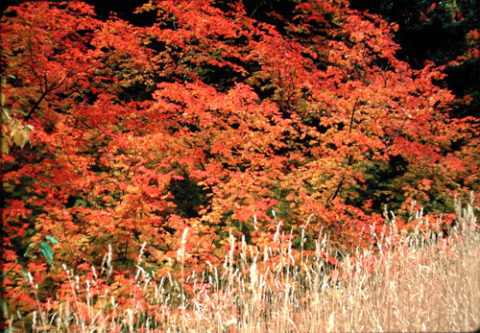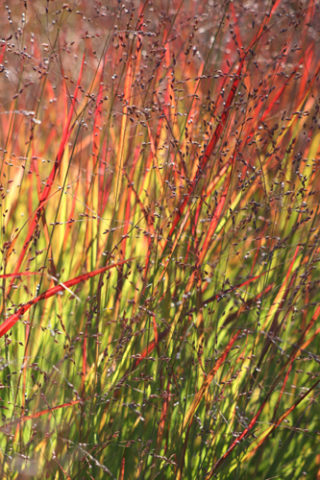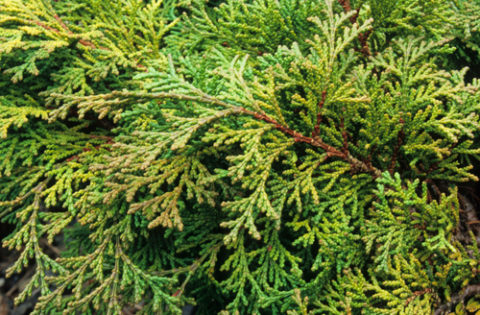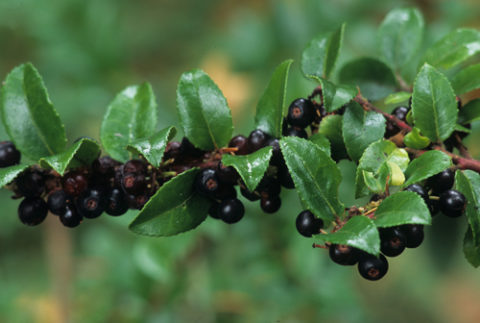Take a look around your landscape in this autumn season. Are your plants providing a show of color and texture? Or are most of them starting to brown and die back?
This is a great time to look for plants that provide visual interest in the fall and winter. Here are a few of our favorites.
Plants for fall interest

Vine maple (Acer circinatum) is a lovely and adaptable native tree. © Great Plant Picks.
Vine maple
Vine maple is one of our best native trees for the urban garden. This multi-stemmed tree is very closely related to Japanese maples, but it has a more relaxed feel, with sprawling branches. Young leaves are green, turning orange and red in fall.
Vine maple may grow 10-15 feet tall and wide, depending on variety. It adapts to a wide range of soil and light conditions. Best fall color is with at least a half day of sun.
Vine maple is a handsome tree, desired for its outstanding fall colors. This tough little tree is long-lived. it provides local wildlife with food and nesting places. You can’t make a better choice for fall interest.
Japanese maple

This red lace-leaf Japanese maple (Acer palmatum tamukeyama) holds its burgundy-red foliage color though the summer. © Great Plant Picks.
These graceful and elegant trees offer year-round interest with their changing colors. They are an excellent addition to most gardens. They are easy to care for once established. Some can even be grown in large pots, making them a good choice for patios.
Both spring and fall leaves may be colorful, depending on the variety. Fall brings the most dramatic color. Winter branches offer a sculptural quality.
There is a wide variety of colors as well as forms, such as upright, weeping or mounding. Leaves are either palm-shaped or delicate and lacy. Sizes can range from two feet to 30 feet.
Here is a guide on choosing Japanese maples from Monrovia and a list of recommended Japanese maples from Great Plant Picks. You may want to visit your local nursery to see which maples offer the fall interest and color you prefer.

Switch grass ‘Shenandoah’ (Panicum virgatum ‘Shenandoah’) is a beautiful grass with red-toned foliage and a graceful habit. © Richie Steffen / Great Plant Picks.
Ornamental grasses
Grasses can be the highlight of the garden in autumn, when many flowering plants are dying back.
Many grasses produce lovely seed heads in late summer and fall. These can remain into winter, providing many months of visual interest in the garden. The spent stalks also attract birds in winter.
Grasses are great additions to the landscape, providing movement and mounds of colorful texture. They range in size from one foot to seven or eight feet tall. You can find grasses for sunny or shady conditions and for different types of soil.
Here is a few suggestions for ornamental grasses.
- 21 recommended ornamental grasses from Great Plant Picks
- A few suggestions from the Seattle Times
- List of gorgeous grasses from eGardenGo
Plants for winter interest
Hinoki cypress

This dwarf hinoki cypress (Chamaecyparis obtusa ‘Kosteri’) is a beautiful small conifer. © Great Plant Picks.
There are several varieties of this elegant and attractive evergreen, with growing heights ranging from one foot to 15 feet. All are slow growing and attract attention for their form and texture. Colors range in shades of green, blue or golden.
Hinoki cypress makes a wonderful specimen plant. Smaller varieties are a good choice for containers.
Hinoki cypress grows best in full sun but tolerates light to dappled shade. It is very drought tolerant and requires little pruning.
Here is a list of 10 Hinoki cypresses from Great Plant Picks.
Evergreen huckleberry

Evergreen huckleberry (Vaccinium ovatum) is a versatile and underused plant. © Richie Steffen / Great Plant Picks
This native plant is handsome and versatile. Its glossy, leathery leaves are coppery in spring and mature to dark green.
Small white flowers in spring are followed by succulent blue-black berries by late summer. It grows in shady or sunny areas. Many birds and animals are attracted to the berries, and pollinators use the flowers.
The berries ripen in August or September and often remain on the plant until December. They are a bit tedious to pick but delicious in jam or muffins.
Evergreen huckleberry grows to about six feet tall and wide, and it does well in both sun and dappled shade. It is drought tolerant and requires little pruning to remain attractive.
More choices
The Garden Hotline has a list of recommended evergreen trees and shrubs.
